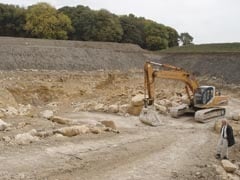Ancaster and Hooby Lane limestone quarry operators Goldholme Stone have secured planning permission for additional reserves that are expected to last up to 30 years for their environmentally friendly natural stone.
Goldholme have had an independent study carried out to verify the environmental impact of their quarrying operations. The study was researched and compiled by environmental assessment consultants Halletec Associates and the results show their stone has less than half the environmental impact of bricks.
Despite the downturn in the economy, Goldholme say demand for their limestones continues to increase.
The stones from Hooby Lane and Ancaster have been chosen for several prestigious projects all over the UK from the Tower of London to Blenheim Palace.
Lately they have been used for major developments in London’s Park Lane and Belgravia and work is currently under way supplying 4.5m Hooby Lane stone arches for George Gilbert Scott’s 19th century Midland Hotel, currently being renovated, at the front of London’s St Pancras railway station.
The station was re-opened by the Queen in November 2007 following an £800million refurbishment that also used Hooby Lane stone, following its assessment by English Heritage to ensure its suitability for use on this prestigious project.
Hooby Lane quarry was a Greenfield site opened by Goldholme in 2004. It gained widespread national press coverage just before full scale production started in 2005 when it was found to contain traces of gold – not enough to be worth recovering but plenty for a PR coup.
It has taken two years and four revisions of the planning application to achieve permission to extend the quarry, but in the end eight of the nine committee members voted in favour of the Hooby Lane extension.
The approval means up to 300,000 tonnes of limestone, quarried in Stretton in Rutland, will be available, securing the availability of the stone for another 10 years.
At Ancaster, meanwhile, Goldholme have been given permission for an extension to their existing quarry that will allow them to extract up to 1.2million tonnes of the stone over 30 years.
The site of the Ancaster quarry is steeped in Roman history. Archeological evidence suggests it was once a Roman fortress occupied by the 9th Legion of Emperor Claudius in AD45. There is also evidence of a middle Iron Age settlement on the site.
Goldholme have agreed to meet the estimated £40,000 cost of an archeological exploration of the site over the next 12 months prior to working the area.
Goldholme MD Phil Kerry told NSS: “We’re delighted to have secured these additional reserves. It will give architects, clients and contractors additional confidence in our ability to produce large quantities of stone with the continuity of supply they need.”

